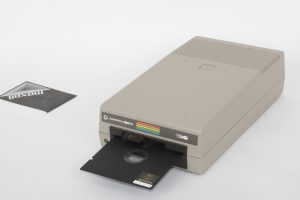1.7: Scientific and Engineering Notation
( \newcommand{\kernel}{\mathrm{null}\,}\)

Powers of Ten
Decimal notation is based on powers of
We represent these powers with negative exponents:
Negative exponents:
Note: This is true for any base, not just
With our base
If you haven’t watched the video “Powers of Ten” from 1977 on YouTube, take ten minutes right now and check it out. Your mind will never be the same again.
Scientific Notation
Let’s consider how we could rewrite some different numbers using these powers of
Let’s take
Looking in the other direction, a decimal such as
The idea behind scientific notation is that we can represent very large or very small numbers in a more compact format: a number between
A number is written in scientific notation if it is written in the form
Note: An integer is a number with no fraction or decimal part: …
1. The mass of the Earth is approximately
- Answer
-
Clearly, it is difficult to keep track of all those zeros. Let’s rewrite those huge numbers using scientific notation.
Earth’s mass is larger because it’s a
2. The mass of the Earth is approximately
- Answer
-
Earth’s mass is about ten times larger, because the power of
It is much easier to compare the powers of
We can apply scientific notation to small decimals as well.
3. The radius of a hydrogen atom is approximately
- Answer
-
A chlorine atom’s radius is larger because it has
Again, keeping track of all those zeros is a chore. Let’s rewrite those decimal numbers using scientific notation.
4. The radius of a hydrogen atom is approximately
- Answer
-
The chlorine atom has a larger radius because its power of
The radius of the chlorine atom is larger because it has a larger power of
Scientific notation is very helpful for really large numbers, like the mass of a planet, or really small numbers, like the radius of an atom. It allows us to do calculations or compare numbers without going cross-eyed counting all those zeros.
Write each of the following numbers in scientific notation.
5.
6.
7.
8.
Convert the following numbers from scientific notation to standard decimal notation.
9.
10.
11.
12.
- Answer
-
5.
6.
7.
8.
9.
10.
11.
12.
You may be familiar with a shortcut for multiplying numbers with zeros on the end; for example, to multiply
Multiply each of the following and write the answer in scientific notation.
13.
14.
15.
16.
- Answer
-
13.
14.
15.
16.
When the numbers get messy, it’s probably a good idea to use a calculator. If you are dividing numbers in scientific notation with a calculator, you may need to use parentheses carefully.
The mass of a proton is
17. Divide these numbers using a calculator to determine approximately how many times greater the mass of a proton is than the mass of an electron.
18. What is the approximate mass of one million protons? (Note: one million is
19. What is the approximate mass of one billion protons? (Note: one billion is
- Answer
-
17. the proton’s mass is roughly
18.
19.
Engineering Notation
Closely related to scientific notation is engineering notation, which uses only multiples of
One thousand =
In engineering notation, the power of
A number is written in engineering notation if it is written in the form
Note: Prefixes for large numbers such as kilo, mega, giga, and tera are essentially engineering notation, as are prefixes for small numbers such as micro, nano, and pico. We’ll see these next.
Measurement Prefixes: Larger
Now let’s turn our attention to converting units based on their prefixes. We’ll start with large units of measure.
| tera- (T) | giga- (G) | mega- (M) | kilo- (k) | [base unit] |
| trillion | billion | million | thousand | one |
Notice that the powers of these units are multiples of
Using computer memory as an example:
Note: There can be inconsistencies with different people’s understanding of these prefixes with regards to computer memory, which is counted in powers of

23. A
24. How many times greater is the storage capacity of a
25. In an article describing small nuclear reactors that are designed to be retrofitted into coal plants, Dr. Jose Reyes of Oregon State University says “One module will produce
26. In the same article, Dr. Reyes says “a
27. The destructive power of nuclear weapons is measured in kilotons (the equivalent of
- Answer
-
23. the capacity increased by a factor of
24.
25.
26.
27.
Measurement Prefixes: Smaller
Now we’ll go in the other direction and look at small units of measure.
| [base unit] | milli- (m) | micro- (μ or mc) | nano- (n) | pico (p) |
| one | thousandth | millionth | billionth | trillionth |
The symbol for micro- is the Greek letter μ (pronounced “myoo”). Because this character can be difficult to replicate, you may see the letter “u” standing in for “μ” in web-based or plaintext technical articles… or you may see the prefix “mc” instead.
Again, the powers are multiples of
…and so on.
See https://physics.nist.gov/cuu/Units/prefixes.html for a list of more prefixes.
28. An article about network latency compares the following latency times: “So a
29. The wavelength of red light is around
30. Nuclear radiation is measured in units called Sieverts, but because this unit is too large to be practical when discussing people’s exposure to radiation, milliSieverts and microSieverts are more commonly used. In 1986, workers cleaning up the Chernobyl disaster were exposed to an estimated dose of
- Answer
-
28.
29. the ratio of the wavelengths of infrared and red is around
30. this is equivalent to
- For some reason, although we generally try to avoid using the "x" shaped multiplication symbol, it is frequently used with scientific notation. ↵
- August 27, 2020 estimate from https://www.census.gov/popclock/↵
- August 27, 2020 estimate from https://www.census.gov/popclock/↵
- August 27, 2020 data from fiscaldata.treasury.gov/datasets/debt-to-the-penny/debt-to-the-penny↵
- https://www.kgw.com/article/news/local/oregon-company-get-approval-to-build-nuclear-power-plants/283-7b26b8cd-12d5-4116-928a-065731f7a0f6 ↵
- https://en.Wikipedia.org/wiki/Nuclear_weapon_yield ↵
- https://www.noction.com/blog/network-latency-effect-on-application-performance ↵
- http://labman.phys.utk.edu/phys222core/modules/m6/The%20EM%20spectrum.html ↵
- https://en.Wikipedia.org/wiki/Chernobyl_disaster ↵
- https://www.cancer.org/treatment/understanding-your-diagnosis/tests/understanding-radiation-risk-from-imaging-tests.html ↵


